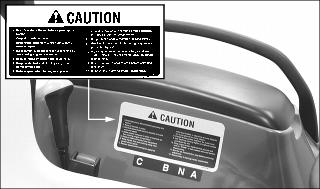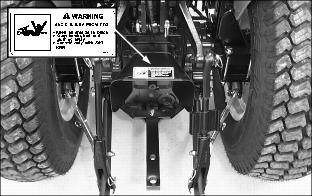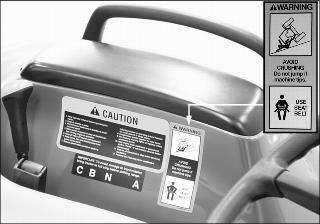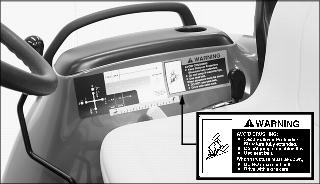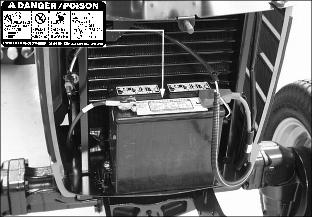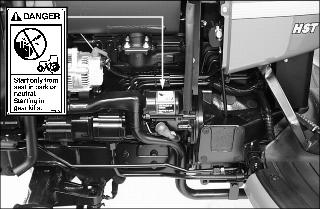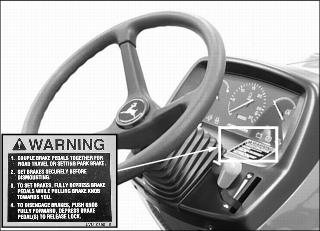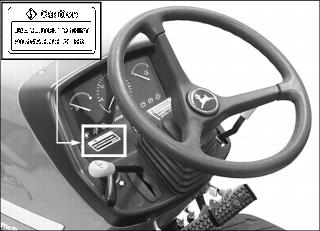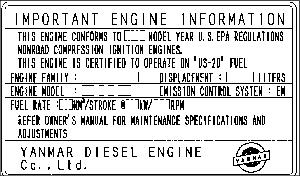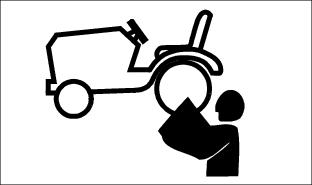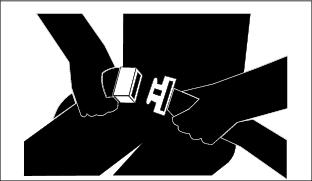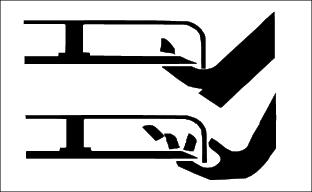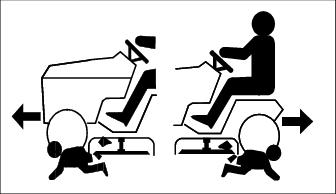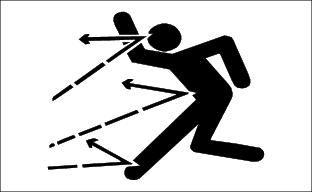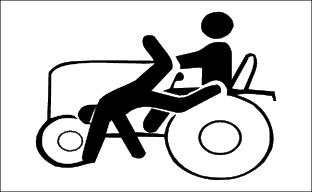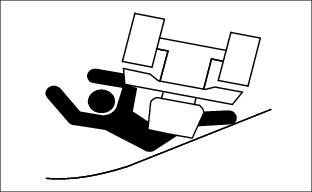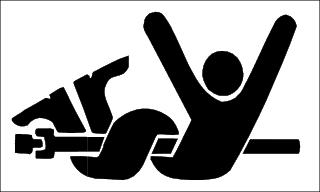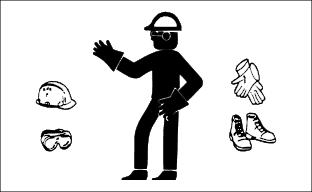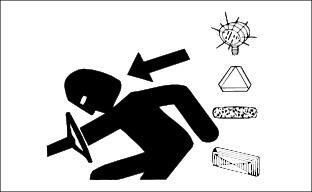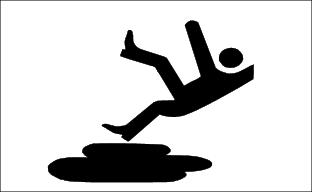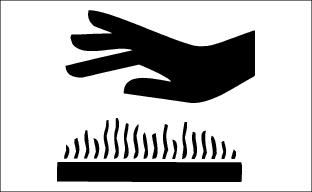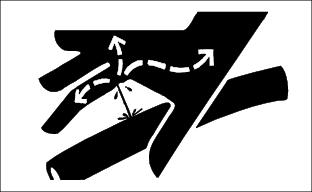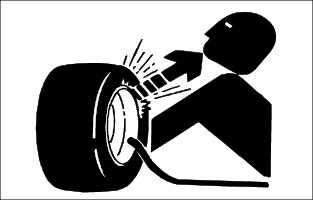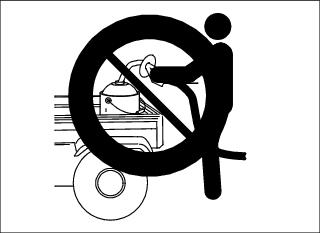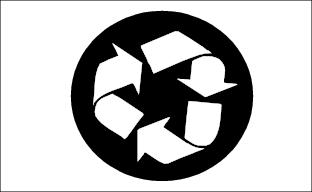PIN (122001-) (133001-) (144001-)
IntroductionProduct Identification
Safety
Understanding The Machine Safety Labels
CAUTION: READ OPERATOR'S MANUAL
WARNING: AVOID INJURY FROM PTO
Emissions Control System Certification Label (NonRoad Diesel)
Stay Clear of Rotating Drivelines
Driving Safely on Public Roads
Handling Waste Product and Chemicals
Operating
Replacement Parts
Service Intervals
Service Lubrication
Service Engine
Service Transmission
Service Electrical
Service Miscellaneous
Troubleshooting
Storage
Assembly
Specifications
Warranty
John Deere Quality Statement
Service Record

Safety
Understanding The Machine Safety Labels
The machine safety labels shown in this section are placed in important areas on your machine to draw attention to potential safety hazards.
On your machine safety labels, the words DANGER, WARNING, and CAUTION are used with this safety-alert symbol,. DANGER identifies the most serious hazards.
The operator's manual also explains any potential safety hazards whenever necessary in special safety messages that are identified with the word, CAUTION, and the safety-alert symbol,.
CAUTION: READ OPERATOR'S MANUAL
1. Read Operator's Manual before operating this tractor.
3. Hitch towed loads only to drawbar to avoid rearward upset.
4. Make certain everyone is clear of machine before starting engine or operation.
5. Keep all riders off tractor and equipment.
6. Keep hands, feet and clothing away from power-driven parts.
7. Reduce speed when turning or applying individual brakes or operating around hazards on rough ground or steep slopes.
8. Couple brake pedals together for road travel.
9. Use flashing warning lights on highway unless prohibited by law.
10. Stop engine, lower implement to ground and shift to "PARK" or set brake(s) securely before dismounting.
11. Wait for all movement to stop before servicing machinery.
12. Remove key if leaving tractor unattended.
WARNING: AVOID INJURY FROM PTO
· Keep hands, feet and clothing away.
CAUTION: HOT SURFACE
WARNING: AVOID CRUSHING
WARNING: AVOID CRUSHING
Picture Note: Label attached to right fender when tractor is equipped with a folding ROPS.
· Keep Rollover Protective Structure fully extended.
· Do not jump if machine tips.
DANGER/POISON
DANGER
|
Picture Note: Remove left side panel to locate safety label. |
WARNING
1. COUPLE BRAKE PEDALS TOGETHER FOR ROAD TRAVEL OR SETTING PARK BRAKE.
2. SET BRAKES SECURELY BEFORE DISMOUNTING.
3. TO SET BRAKES, FULLY DEPRESS BRAKE PEDALS WHILE PULLING BRAKE KNOB TOWARDS YOU.
4. TO DISENGAGE BRAKES, PUSH KNOB FULLY FORWARD, DEPRESS BRAKE PEDAL(S) TO RELEASE LOCK.
CAUTION
Picture Note: Safety label installed on SRT model tractors only.
USE CLUTCH TO SHIFT FORWARD/REVERSE
Emissions Control System Certification Label (NonRoad Diesel)
The emissions warranty described in the warranty section applies only to those engines marketed by John Deere that have been certified by the United States Environmental Protection Agency (EPA) and/or California Air Resources Board (CARB); and used in the United States in non-road mobile (self-propelled or portable/transportable) equipment which is moved at least once every 12 months. The presence of an emissions label like the one shown signifies that the engine has been certified with the EPA and/or CARB. The EPA and CARB warranties only apply to new engines having the certification label affixed to the engine and sold as stated above in the geographic areas governed by the regulating agencies.
NOTE: The hp/kW rating on the engine emissions certification label specifies the gross engine hp/kW, which is flywheel power without fan. In most applications this will not be the same rating as the advertised vehicle hp/kW rating.
Operator Training Required
· Do not allow operation of the machine by untrained persons.
· Read the operator manual and study the safety and operation sections before operating the machine.
· Operate the machine in an open, unobstructed area under the direction of an experienced operator.
· Learn the use of all controls.
· Operator practice is required to learn the moving, stopping, turning and other operating characteristics of the machine.
Operating Safely
· Inspect machine before you operate. Be sure hardware is tight. Repair or replace damaged, badly worn, or missing parts. Be sure guards and shields are in good condition and fastened in place. Make any necessary adjustments before you operate.
· Do not operate mower without discharge chute or entire grass catcher in place.
· Check before each use that operator presence controls are functioning correctly. Test safety systems. Do not operate unless they are functioning correctly.
· Do not change the engine governor setting or overspeed the engine.
· Always wear seat belt if machine has a standard ROPS or a folding ROPS in the upright position.
· Check brake action before you operate. Adjust or service brakes as necessary.
· Stop machine if anyone enters the area. Make certain everyone is clear of the machine before starting the engine or operation.
· Never raise mower decks when blades are running.
· If you hit an object, stop and inspect the machine. Make repairs before you operate. Keep machine and attachments properly maintained and in good working order.
· Do not leave machine unattended when it is running.
· Only operate during daylight or with good artificial light.
· Slow down and be careful of traffic when operating near or crossing roadways. Stop blades before crossing roads or sidewalks. Use care when approaching blind corners, shrubs, trees, or other objects that may obscure vision.
· Be aware of the mower discharge direction and make sure that no one is in the path of the discharge direction.
· Use only accessories and attachments approved by the manufacturer of the machine.
Use Seat Belt Properly
Rotating Blades are Dangerous
HELP PREVENT SERIOUS OR FATAL ACCIDENTS:
· Rotating blades can cut off arms and legs.
· Keep hands, feet and clothing away from mower deck when engine is running.
· Be alert at all times, drive forward carefully. People, especially children can move quickly into the mowing area before you know it.
· Before backing up, shut off PTO and look down and behind the machine carefully, especially for children.
· Shut off blades when you are not mowing.
· Do not operate machine if you are under the influence of drugs or alcohol.
· Park machine safely before inspecting or unplugging mower or bagger.
PROTECT CHILDREN:
· Never assume that children will remain where you last saw them. Children are attracted to mowing activity, stay alert to the presence of children.
· Keep children indoors when you are mowing. Turn the machine off if a child enters the mowing area.
· Use extra care when you come to blind corners, shrubs, trees, or other objects that may block your vision.
· Do not let children or an untrained person operate the machine.
· Do not carry or let children ride on any attachment or machine even with the blades off. Do not tow children in a cart or trailer.
Checking Mowing Area
· Clear mowing area of objects that might be thrown. Keep people and pets out of mowing area.
· Study mowing area. Set up a safe mowing pattern. Do not mow where traction or stability is doubtful.
· Test drive area with mower lowered but not running. Slow down when you travel over rough ground.
Keep Riders Off
· Only allow the operator on the machine. Keep riders off.
· Riders on the machine or attachment may be struck by foreign objects or thrown off the machine causing serious injury.
· Riders obstruct the operator's view resulting in the machine being operated in an unsafe manner.
Avoid Tipping
· Slopes are a major factor related to loss-of-control and tip-over accidents, which can result in severe injury or death. If you cannot back up the slope or if you feel uneasy on it, do not mow it.
· Do not drive where machine could slip or tip.
· Stay alert for holes and other hidden hazards in the terrain.
· Keep away from drop-offs, ditches and embankments.
· Slow down before you make a sharp turn or operate on a slope. Choose a low gear so that you will not have to stop or shift while on the slope.
· Limit loads to those you can safely control. Use only approved hitches when pulling loads or using heavy equipment. Use counterweights or wheel weights as required in this manual or your attachment manual.
· Use wheel weights for added stability when operating on slopes or using rear mounted attachments.
· Drive up and down a hill - not across. Turn slowly and turn downhill. Do not shift to neutral and coast downhill.
· Do not stop when going up hill or down hill. If machine stops going up hill, disengage mower blades and back down slowly.
· Mowing when grass is wet can cause reduced traction and sliding.
· Do not try to stabilize the machine by putting your foot on the ground.
Stay Clear of Rotating Drivelines
Entanglement in rotating driveline can cause serious injury or death.
· Wear close fitting clothing.
· STOP the engine and be sure PTO driveline is stopped before getting near it.
Checking Wheel Bolts
· A serious accident could occur causing serious injury if wheel bolts are not tight.
· Check wheel bolt tightness often during the first 100 hours of operation.
· Wheel hardware must be tightened to specified torque using the proper procedure anytime it is loosened.
Wear Appropriate Clothing
· Wear close fitting clothing and safety equipment appropriate for the job.
· Always wear safety goggles or safety glasses with side shields when operating the mower.
· Wear a suitable protective device such as earplugs. Loud noise can cause impairment or loss of hearing.
· Do not wear radio or music headphones. Safe service and operation requires your full attention.
Parking Safely
1. Stop machine on a level surface, not on a slope.
3. Lower attachments to the ground.
7. Before you leave the operator's station, wait for engine and all moving parts to stop.
Driving Safely on Public Roads
Practice Safe Maintenance
· Understand service procedure before doing work. Keep area clean and dry.
· Never lubricate, service, or adjust machine while it is moving. Keep safety devices in place and in working condition. Keep hardware tight.
· Keep hands, feet, clothing, jewelry, and long hair away from any moving parts, to prevent them from getting caught.
· Lower attachments to the ground before servicing machine. Disengage all power and stop the engine. Lock park brake and remove the key. Let machine cool.
· Disconnect battery or remove spark plug wire before making any repairs.
· Before servicing the machine, carefully release pressure from any components with stored energy, such as hydraulic components.
· Keep all nuts and bolts tightened, especially blade attachment bolts.
· Never start tractor engine while standing on the ground.
· Securely support any machine elements that must be raised for service work.
· Never run engine unless park brake is locked.
· Keep all parts in good condition and properly installed. Fix damage immediately. Replace worn or broken parts. Replace all worn or damaged safety and instruction decals.
· To prevent fires, remove any buildup of grease, oil, or debris from the machine, especially the engine compartment.
· Charge batteries in an open, well-ventilated area, away from sparks. Unplug battery charger before connecting or disconnecting from the battery. Use insulated tools.
· Do not modify machine or safety devices. Unauthorized modifications may impair its function and safety.
· Do not wear radio or music headphones while servicing the machine. Safe service requires your full attention.
Prevent Fires
· Never remove fuel cap, or add fuel with engine running or hot. Allow engine to cool for several minutes.
· Never store equipment with fuel in the tank inside a building where fumes may reach an open flame or spark.
· Allow engine to cool before storing in any enclosure.
· To reduce fire hazard, keep engine free of grass, leaves, or excessive grease.
Avoid High Pressure Fluids
· Hydraulic hoses and lines can fail due to physical damage, kinks, age, and exposure. Check hoses and lines regularly. Replace damaged hoses and lines.
· Hydraulic fluid connections can loosen due to physical damage and vibration. Check connections regularly. Tighten loose connections.
· Escaping fluid under pressure can penetrate the skin causing serious injury. Avoid the hazard by relieving pressure before disconnecting hydraulic or other lines. Tighten all connections before applying pressure.
· Search for leaks with a piece of cardboard. Protect hands and body from high pressure fluids.
· If an accident occurs, see a doctor immediately. Any fluid injected into the skin must be surgically removed within a few hours or gangrene may result. Doctors unfamiliar with this type of injury should reference a knowledgeable medical source. Such information is available from Deere & Company Medical Department in Moline, Illinois, U.S.A. Information may be obtained in the United States and Canada only by calling 1-800-822-8262.
Tire Safety
Handling Fuel Safely
Fuel and fuel vapors are highly flammable:
· Do not refuel machine while you smoke, when machine is near an open flame or sparks, or when engine is running. Stop engine and allow to cool before filling.
· Never remove the fuel cap or add fuel with the engine running.
· Never fill fuel tank or drain fuel from a machine in an enclosed area. Fill fuel tank outdoors.
· Prevent fires. Clean up spilled fuel immediately.
· Do not store machine with fuel in tank in a building where fumes may reach an open flame or spark.
· Prevent fire and explosion caused by static electric discharge. Use only non-metal, portable fuel containers approved by the Underwriter's Laboratory (U.L.) or the American Society for Testing & Materials (ASTM). If using a funnel, make sure it is plastic and has no screen or filter.
· Static electric discharge can ignite gasoline vapors in an ungrounded fuel container. Remove the fuel container from the bed of a vehicle or the trunk of a car and place on the ground away from the vehicle before filling. Keep nozzle in contact with container opening while filling.
· When practical, remove equipment from trailers or truck beds and refuel them on the ground. If this is not possible, use a portable, plastic fuel container to refuel equipment on a truck bed or trailer.
· For gasoline engines, do not use gas with methanol. Methanol is harmful to your health and to the environment.


